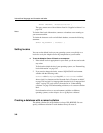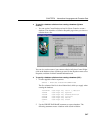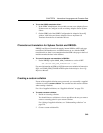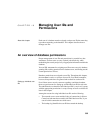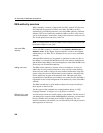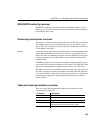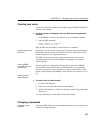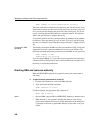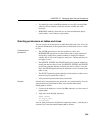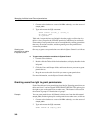
An overview of database permissions
354
DBA authority overview
When a database is created, a single usable user ID is created. This first user
ID is
DBA and the password is initially set to SQL. The DBA user ID is
automatically given DBA permissions, also called DBA authority, within the
database. This level of permission enables the DBA user ID to carry out any
activity in the database: create tables, change table structures, create new user
IDs, revoke permissions from users, and so on.
Note To ensure database security, the DBA needs to change the password from
the default of SQL to a new value.
Users with DBA
authority
A user with DBA authority is referred to as the database administrator or
database owner. In this chapter, frequent reference is made to the database
administrator, or the DBA. This is shorthand for any user or users with DBA
authority.
Although DBA authority may be granted or transferred to other user IDs, in
this chapter it is assumed that the DBA user ID is the database administrator,
and the abbreviation DBA is used interchangeably to mean both the DBA user
ID and any user ID with DBA authority.
Adding new users
The DBA has the authority to add new users to the database. As users are
added, they are also granted permissions to carry out tasks on the database.
Some users may need to simply look at the database information using SQL
queries, others may need to add information to the database, and others may
need to modify the structure of the database itself. Although some of the
responsibilities of the DBA may be handed over to other user IDs, the DBA is
responsible for the overall management of the database by virtue of the DBA
authority.
The DBA has authority to create database objects and assign ownership of
these objects to other user IDs
See the syntax of the commands for creating database objects, in “SQL
Language Elements” in Adaptive Server IQ Reference Manual.
DBA user ID in case
sensitive databases
User IDs and passwords are actually objects in the database. For this reason, if
your database was created with the
CASE RESPECT parameter, you must enter
the user ID DBA and its default password SQL in uppercase. For case
insensitive databases (the default), you can enter this user ID and password in
either uppercase or lowercase.



